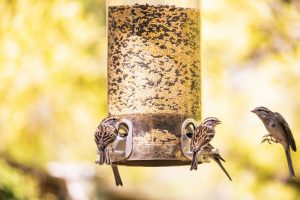
We have learned in so many ways the importance of the cleanliness of bird feeders. The hobby of being able to watch birds of many feathers and colors show up in backyards has proliferated over the last 20 years. There are backyards across the world with elaborate setups that are expressly designed to attract a wide range of birds to their locations. That’s a beautiful thing. But as beautiful as it is, there are dangers to the birds themselves. With the attraction of many birds to even a singular bird feeder, their congregation brings each of them quite close to a life-threatening illness. And as they fly and gather between feeders, infected birds can transmit their illnesses to healthy birds. That, of course, invites the spread of illness even further.
Recently, a Fresno State biology professor, Dr. Tricia Van Laar, discovered a dead
in her backyard. She retrieved the bird and ran tests to discover the cause of death. It was determined that the bird had salmonella, a bacteria that can infect both the avian species and humans at alarming rates. Dr. Van Laar enlisted the aid of fellow California State University Fresno professor Dr. Joel Slade to help study the rapid spread of salmonella in birds. Their studies will bring in three Fresno State biology students, who will help gather data, perform labs, work in the field, and help to write up the findings and present them at conference settings.
Tracking Salmonella in Urban Settings
The research will look closely at how the bacterial scourge of salmonella spreads in urbanized settings, as well as the birds’ abilities to fight off the onslaught of the illness when it is first introduced into their system. This research has far-reaching advantages as it will help scientists gain a foothold on how to better protect our beautiful birds in the wild against bacterial disease. The studies will be undertaken with monitored, on-site bird-feeding stations at both Fresno State and the San Joaquin Experimental Range (a research station that originated in 1934 to help researchers on many projects that are dependent on a healthy ecosystem).
The study, which is being funded by the California State University Program for Education and Research in Biotechnology (CSUPERB), will study the differences in urban and rural house finches to determine the effects of the urban setting on infections and immunity in urban-living wildlife. Apparently, rural finches fight salmonella better than urbanized finches. This will, no doubt, lead to more intensive work and other studies as this study uncovers answers among frightening discoveries. The hope is that the answers will help to alleviate the spread of infection, if not help to eradicate it altogether. In a deeper reality, the study also hopes to discover immune genes in the birds in both settings to help to understand how those genes work overall.
Clean Feeders for Healthy Birds
As a precautionary aspect of the core basis for this important study, it cannot be stated often enough that everyone always keep their feeders as clean as possible. The CDC recommends monthly cleaning of wild-bird feeders, although it might be argued that more frequent cleanings, perhaps weekly, might go further in saving birds in all settings. Bleaching is recommended as the cleaning agent, with thorough rinsing afterward to remove all the bleach. Most important of all, if you are made aware of a local outbreak of disease/infections affecting birds, you should remove your feeder immediately to help lessen the spread.
We are appreciative of the ongoing work of all scientific communities in their tireless efforts to improve the health of our beautiful birds in the wild.
